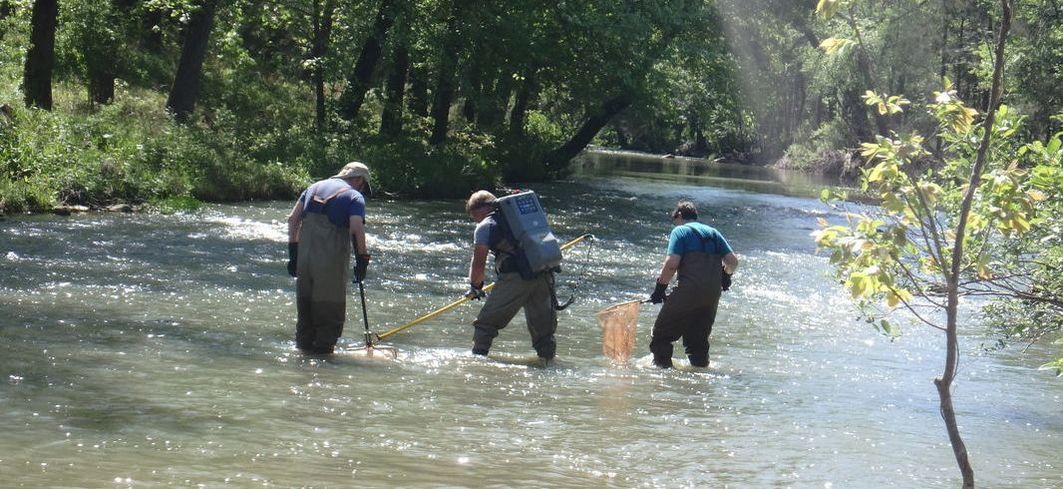 Early in my time here, somebody mentioned an upcoming event that I would attend called Fish School. I wondered, “What exactly is Fish School??” As you might guess or imagine, it is exactly what it sounds like, an opportunity for the Blue Thumb staff to spend a few days having an immersive and intensive learning experience about our local freshwater fish. As part of our biological collections, Blue Thumb performs fish collections every summer, rotating the location so that each region of the state is visited every four or five years. These collections include our volunteers, who help with using a seine to catch the fish as well as taking note of the stream’s habitat. Fish School provides an annual refresher course to the Blue Thumb team, providing an opportunity to see, touch and identify numerous species that might be encountered during fish collections. Being able to identify fish is an essential part of the fish collection process and also increases the excitement for volunteers who may have never seen these fish before. Like some of our volunteers, I went into Fish School with little to no knowledge of our local freshwater fish. A few weeks prior to the event, I did start studying, on the advice of one of our resident fish experts, Nathan Carter. Nathan is one of our water quality monitoring specialists and is among those who organize the agenda of Fish School. He recommended if I wanted to prepare beforehand, I should study species of sunfish, gar, suckers and catfish. The preparation definitely came in handy later, when it was time to start getting to know the fish face-to-face. Fish School began on Monday, when we arrived at Robber’s Cave State Park, where we all stayed at their hotel-style lodge with a spectacular view of the surrounding hills. After checking in, we settled into the conference room for some PowerPoint presentations about fish anatomy, sunfish and the habitat assessment process. After the review (or, in my case, seeing it all for the first time), we headed to nearby Fourche Maline Creek and talked through the habitat assessment technique that our monitoring staff uses whenever they visit a stream. We were originally scheduled to talk about bug collections and other topics, but the recent rains made the creek too high and too fast. That may have been good for me, since it provided me with more time to spend in the creek, learning about habitat assessments. Along with Nathan, monitoring specialists Jason Ramming and Leonard Moore, as well as Blue Thumb’s own Candice, we walked up the stream providing lots of habitat lessons and information along the way. The immersive educational experience continued on Tuesday, as we all drove to Black Fork of Poteau River for more discussion of habitat and our first look at fish species. It was a gorgeous drive through rolling green hills, forests and farmland, right to the river’s edge. We split up and began collecting fish, some of us on foot, using a portable electric-shock device and nets, while others rode on a boat also equipped with an electric-shock device. This allowed us to stun the fish just for a moment, catch them in a net, examine them and release them back into the water alive and well. Doing this kind of fishing, both on foot in the creek and from the boat, was a totally new and fascinating experience for me. As a whole, it was a pretty amazing day, personally, especially since I was the least experienced fish person in the group. I got to see multiple kinds of gar, sunfish and bass, along with a number of different darters and minnows, all for the first time. More firsts happened on Wednesday, as we went to another spectacular spot, Holson Creek. There, we did more fishing, although I didn’t take part in that as much as I had the day before. I did get to do some seining for fish with another of our monitoring specialists, Wes Shockley, who also helped me prepare for the upcoming habitat assessment test. During our time at that creek, we also had our discussion on bug collections and continued to find and examine various fish species. Later that day, we went back to Fourche Maline Creek for the habitat assessment test, a way for everyone involved to make sure they are looking at and describing stream habitat in the same way. Kim and Jean helped me along the way as we walked two hundred meters of stream, taking note of everything from water depth to riparian area width to the materials making up the creek’s bottom. Similar to the habitat assessment test, the fish exam on the final day of Fish School is a way to test everyone’s ability to identify fish and ensure everyone can identify different species correctly. For me, it was definitely a challenge, although I had been studying and preparing, so I definitely did better than if I had gone into it completely cold. It was a beautiful day to be at the water and, for me, a true learning experience. It also only scratched the surface of everything I need and want to continue to learn about. Fish School was four days of connecting with nature and the outdoors, being immersed in all its beauty, and learning about many of its inhabitants. And it’s just the beginning of the enormous education this job will continue to provide.
0 Comments
Your comment will be posted after it is approved.
Leave a Reply. |
The Blue Thumb Blog
Archives
July 2018
Categories
|



 RSS Feed
RSS Feed